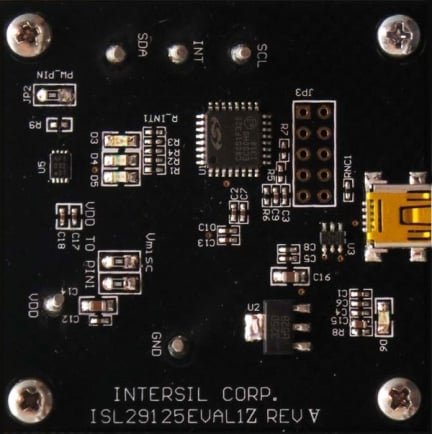Overview
Description
The RGB Evaluation Kit is designed to evaluate the performance of the ISL29125 RGB sensor. The kit is accompanied by a graphical user interface (GUI) that contains the CIE 1931 Chromaticity diagram with Planckian locus in an x, y- coordinate system, with cross marks to point out where the RGB sensor position is on the graph. The GUI facilitates evaluation of parameters such as raw data of Red, Green and Blue as well as X, Y and Z corrected lux measurements and also performs interrupt functions. Data can be viewed on the GUI and/or saved to a text file for future analysis. The GUI software is compatible with Windows XP®, Windows Vista®, and Windows® 7. This provides a simple user interface for exercising the device features.
The system (MCU, DUT) is powered directly from the universal serial bus (USB) or from a single-supply voltage of 2.25V to 3.6V. The evaluation board must be connected to a computer through the mini USB port for the system to function. The system uses a USB MCU to communicate to the DUT via I2C/SMBus interface.
Features
- 56µA operating current, 0.5µA shutdown current
- Selectable range (Via I2C)
- I2C (SMBus compatible) output
- ADC resolution 16 bits
- Programmable interrupt windows
- Two optical sensitivity ranges
- Range 0 = 5.7m lux to 375 lux
- Range 1 = 0.152 lux to 10,000 lux
- Operating power supply 2.25V to 3.63V
- I2C power supply 1.7V to 3.63V
- 6 Ld ODFN (1.65mm x 1.65mm x 0.7mm) package
Applications
- Smartphones, PDAs, GPS, tablet PCs, LCD-TVs, digital picture frames, digital cameras
- Dynamic display color balancing
- Printer color enhancement
- Industrial/Commercial LED lighting color management
- Ambient light color detection/correction
- OLED display aging compensation
Documentation
|
|
|
|
|---|---|---|
| Type | Title | Date |
| Application Note | PDF 1.43 MB | |
| Other | PDF 325 KB | |
| Datasheet | PDF 902 KB | |
| Manual - Development Tools | PDF 1.74 MB | |
4 items
|
||
Design & Development
Videos & Training
In this video Intersil demonstrates of the ISL29125 evaluation board. Discover the color temperature accuracy of the ISL29125.
Transcript
Hi. My name is Paul Traynham. I'm a senior field application engineer for Renesas, and today I want to talk about a brand new light sensor called the ISL29125 and it's an RGB light sensor and we're going to demo the eval card for you today.
Okay, so just to talk a little bit about the new light sensor ALS + RGB sensor, the ISL29125, the part has three photo diodes as you can see here in the block diagram. There are one set of arrays for red green and blue and that light current is processed and digitized through an integrating ADC, and that information is then passed on through the I2C bus out to any microcontroller can be used or microprocessor, very simple micro. The I2C bus can be used to set up different data registers and set different things within the chip, but it also allows you to output the data coming from the RGB sensors. In the lower left hand corner we have a normalized spectral sensitivity for each of the three colors, red, green and blue, and you can see in the wavelength of each of the three colors, green matches up very, very closely with ambient light so when you get an ambient light reading, it's essentially the same as the green reading.
Up in the right corner is a snapshot of the actual die and where you can see some IR compensation. This is to allow you to put the part behind glass which blocks out ambient light but, or filters any kind of light, but allows IR components to come through. So it allows you to do a better job of filtering IR light, and then you see the RG and the components of the diode array. The part comes in a very small 1.6mm x 1.6mm package so it makes it very, very small. One of the applications might be on a cellphone for example, you might want to do white balancing for the camera or you may want to adjust the contrast or color of the display based on the light in the room or the color temperature of the room.
Okay, so I have plugged our ISL29125 RGB ALS into the USB port and then you do that first, and then launched the chromameter application, the GUI that you would get off of our website or on your CD that comes with the eval card. So once you launch that it looks like this and you get readings, you get red, green, and blue. We also do a conversion for you mathematically to XYZ or XYUV if you prefer. We also give you a measurement, a lux measurement shown here, and we do a calculated color temperature for you. So right now we're reading about 3454, and if we compare that to a professional meter and this is not completely scientific method here because I've got them side by side about as close as I can get, they're not on exactly the same level but it's fairly close. And a professional meter has a diffuser so its not going to be exact, but so I'm reading 3455 on our part and then on the meter I'm reading 3357. So fairly close, and something else I can show you, if I change the light source so we have a florescent light in our lab here, we'll turn that on and you see our temperature change. Now I'm reading 3749 on the ISL29125 and I'm reading 3702. It's actually a little bit closer so the lux went up, so when the lux went up it got a little bit more accurate reading between the two parts.
You can get more information on our website.


